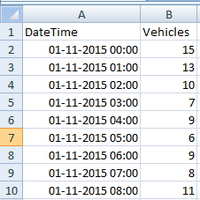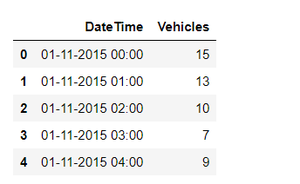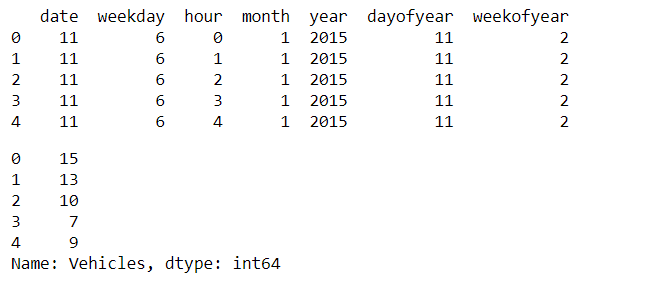从传感器数据预测车辆数量
先决条件:回归和分类|有监督的机器学习
安置在路口的传感器收集不同路口的车辆数量数据,并将数据提供给运输经理。现在我们的任务是根据传感器的数据来预测车辆总数。
本文解释了如何处理带有时间戳的传感器数据,并预测某一特定时间内的车辆数量。
数据集描述:
这个数据集包含2个属性。它们是日期和车辆。其中车辆是类标签。
下载此数据的链接 – 点击这里
类标签是数字型的。所以回归技术很适合这个问题。回归是用来将数据映射到一个预定义的函数中,它是一种有监督的学习算法,用来预测基于历史数据的数值。如果数据是数字的,我们可以对数据进行回归。这里的类标签Ie车辆属性是数字的类标签,所以应该进行回归。
随机森林调节器是一种集合技术,它接受输入并建立树,然后取每行/每元组所有树的平均值。
语法:
RandomForestRegressor(n_estimators=100, *, criterion=’mse’, max_depth=None, min_samples_split=2, min_samples_leaf=1, min_weight_fraction_leaf=0.0, max_features=’auto’, max_leaf_nodes=None,min_impurity_decrease=0.0, min_impurity_split=None, bootstrap=True, oob_score=False, n_jobs=None,random_state=None, verbose=0, warm_start=False, ccp_alpha=0.0, max_samples=None)
步骤:
- 导入必要的模块
- 加载数据集
- 分析数据
- 将DateTime属性转换为周、日、小时、月等(是时间戳格式的)。
- 建立模型
- 训练模型
- 测试数据
- 预测结果
第1步:导入pandas模块,用于加载数据框架。
# importing the pandas module for
# data frame
import pandas as pd
# load the data set into train variable.
train = pd.read_csv('vehicles.csv')
# display top 5 values of data set
train.head()
输出:
第2步:定义从时间戳(DateTime)中获取月、日、小时的函数,并将其载入不同的列中。
# function to get all data from time stamp
# get date
def get_dom(dt):
return dt.day
# get week day
def get_weekday(dt):
return dt.weekday()
# get hour
def get_hour(dt):
return dt.hour
# get year
def get_year(dt):
return dt.year
# get month
def get_month(dt):
return dt.month
# get year day
def get_dayofyear(dt):
return dt.dayofyear
# get year week
def get_weekofyear(dt):
return dt.weekofyear
train['DateTime'] = train['DateTime'].map(pd.to_datetime)
train['date'] = train['DateTime'].map(get_dom)
train['weekday'] = train['DateTime'].map(get_weekday)
train['hour'] = train['DateTime'].map(get_hour)
train['month'] = train['DateTime'].map(get_month)
train['year'] = train['DateTime'].map(get_year)
train['dayofyear'] = train['DateTime'].map(get_dayofyear)
train['weekofyear'] = train['DateTime'].map(get_weekofyear)
# display
train.head()
输出:
第3步:分离类标签,并存储到目标变量中。
# there is no use of DateTime module
# so remove it
train = train.drop(['DateTime'], axis=1)
# separating class label for training the data
train1 = train.drop(['Vehicles'], axis=1)
# class label is stored in target
target = train['Vehicles']
print(train1.head())
target.head()
输出:
第四步:使用机器学习算法创建和训练数据,并预测测试后的结果。
#importing Random forest
from sklearn.ensemble import RandomForestRegressor
#defining the RandomForestRegressor
m1=RandomForestRegressor()
m1.fit(train1,target)
#testing
m1.predict([[11,6,0,1,2015,11,2]])
输出:
array([9.88021429])
 极客教程
极客教程


